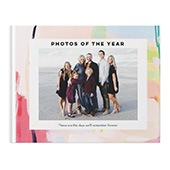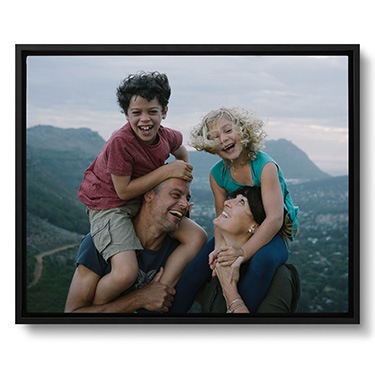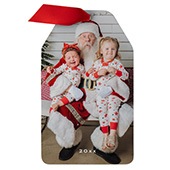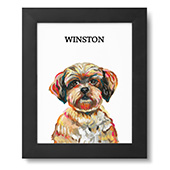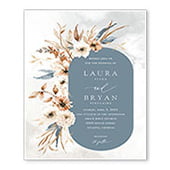Are you in need of a room refresh? Now that you may be spending more time at home and taking on home decor projects, use this wall art size guide to give your space the makeover it needs! Hanging wall art is a good step in achieving your design goals and can really pull a room together.
Choosing wall art prints that are right for your space is an important part of the interior design process. Whether it’s a unique standalone piece, canvas wall art, or a gallery of photo prints, the size of the piece of art matters. If you go too big, your space may look too busy, but on the flip side, it can look empty. Whether you’re redecorating your bedroom or living room, following size and style guidelines can balance your space and ensure you maintain an eye-catching design.
Figuring out the perfect size, how to arrange, and how to hang your wall art doesn’t have to be overly challenging. When done right, it can really be the perfect final touch to your space. We’ve put together this wall art size guide to make designing your space a breeze.
Wall Art Sizes 101
There are many different sizes to choose from when it comes to decorating a space with wall art, and knowing how to pick can be challenging. However, this is an important step in ensuring your space doesn’t look incomplete or cluttered. To help you get started, here’s a breakdown of the varieties of sizes that you can choose from based on your space and wall art goals.
Small Wall Art
Wall art that’s on the small side consists of sizes that range between 18 and 24 inches in height and width. Choosing small wall art can be perfect for decorating shelves or for when you’re grouping together a series for a gallery. These sizes are also great for arranging framed photos or prints.
When decorating a room with limited wall space, like a bathroom or dorm room, choosing smaller pieces is the way to go. With this size, you can easily hang in pairs or in groups of three if needed.
Medium-Sized Wall Art
When picking medium-sized wall art, you’re typically looking at sizes between 25 to 32 inches (two to three feet) in height and width. Choosing a medium size makes for great office wall art without adding too much distraction and clutter. Medium sizes are also great for hallways and foyers.
Wall art prints of this size can either stand-alone or be grouped together. If your medium piece looks too small on your wall, hang a series of similarly sized vertical pieces to create a set. These wood wall art pieces have a perfect medium 24 by 36-inch size option.
Large Wall Art
For a polished look, choose a large wall art size. With a size range of 33 and 40 inches (two-and-a-half to four feet) in width and height, large wall art is great as a centerpiece for your space. With large wall art, avoid grouping together with other similar sized prints as you can quickly overcrowd your space.
Large art pieces are great as classic, standalone pieces, or even to help balance smaller wall art. For example, you can hang a large wall art piece next to a couple of smaller ones to create an interesting, collective art gallery look. This size would be great to show off canvas prints, as this type of custom wall art is usually on the larger side.
How To Choose The Best Wall Art Size
To start, you have to make sure the piece of wall art you’re hanging is well proportioned for the spot you’re going to hang it. The two main things to consider here are the size of the piece and how high you’re going to hang it. Marking out potential dimensions on your wall with a pencil or tape is a great outline to get an idea of the size direction you’ll need to head in!
First, measure the height and length of the wall you want to hang wall art on with a tape measure. Then, multiply the height by .57 and .75 and the length by .57 and .75. These calculations will tell you that the artwork you choose should have its measurements within these ranges.

When choosing the best wall art size based on your furniture, these calculations also apply. For example, if your couch is 84 inches wide, then your wall art should be within the 47 and 63-inch wide range in order to complement the space.
Be sure to keep in mind the orientation of your wall art. For example, photo wall art or canvas wall art that’s in a landscape position will look better over a couch or bed, while portraits tend to look nice on narrower walls, such as in bathrooms or office spaces.
If you want to take a simpler route and avoid doing too much math, eyeball it and make sure the wall art covers about two thirds to three-fourths of your available wall space or width of the furniture.
How To Arrange Your Wall Art
Now that you know what sizes of wall art you want to use and what walls to decorate, it’s time to arrange your wall art into a cohesive design. Looking at a blank wall can be intimidating when trying to figure out how to arrange your wall art — you have to let your personal style and the space itself guide your decisions. Read more for some tips and tricks on hanging different types of arrangements.
Gallery Wall
Designing a gallery wall is a unique and fun way to decorate your space and show off your custom wall art! To start, trace out the dimensions of your art onto paper and cut them out. This allows you to rearrange the layout on your floor first, rather than putting too many holes in your wall. Be sure to take pictures on your phone so you can reference the arrangement when you go to hang everything.

When arranging your gallery wall, make sure there is enough space around each piece, about two or three inches. This helps you avoid a layout that looks too messy and thrown together. Since we often read from left to right, placing larger and busier pieces on the left side can also work in your favor.
If you only want to hang three pictures in a row, the best way to do this is to hang vertically and space each piece about three to four inches apart. This approach looks great in hallways or above a couch.
The best part about gallery walls is their ability to keep growing — feel free to keep adding more wall art prints, such as acrylic prints and framed prints when you want to change things up!
Arranging Wall Art on Shelves
The use of floating shelves is another way to decorate your space and is an option if you don’t want to put too many holes in your wall. They’re also great for displaying metal prints!
There are a few options when arranging your shelves. Mounting your shelves staggered on your wall allows you to create a layered look that gives a unique vignette of texture and color. Placing the shelves in a single line creates a more uniform look and is great for long, narrow spaces with lower ceilings.
Arranging your wall art on shelves lets you incorporate a variety of sizes to display which is super convenient if you have a hard time deciding! Since this arrangement is so flexible, you can quickly swap out for another piece depending on your mood or season.
Centerpiece Wall Art
Maybe you have one piece that you really want to show off in your space. Oversized wall art, if done right, can create a nice focal point for the room and fill up the wall in just the right way.

If you have enough space on your wall, a centerpiece can help ground a gallery and serve as the focal point. If you can’t decide between two sizes, go bigger. Having a centerpiece that’s too small on a large wall will just look like an afterthought and could even make your space feel smaller.
Staircase Wall Art
Another popular way of arranging wall art is along your staircase. This a creative idea that’s great for brightening up a dark stairwell or utilizing unused space. This classic arrangement also draws the eye upward and can make the ceiling in your place appear higher.
To begin, start by arranging your wall art prints on the floor to give yourself an idea of where you want these pieces to hang. Then, imagine a straight line that runs parallel to the angle of the stairs. The goal is to place your wall art so that this imaginary straight line runs through the center of the largest prints, while just the corners of smaller prints are just barely touching the line. This will help ensure that your wall art is even and looks its best.
This style is best used for staircases that aren’t too narrow and have enough space so that you won’t knock them over.
How To Hang Your Wall Art
Now that you’ve chosen your sizes and arranged the layout, it’s time to hang your wall art prints! Make sure you’re fully equipped with the right hanging equipment.
Once you’ve marked on your wall with a pencil or tape where you want to place your wall art, make sure you take note of how high your wall art will hang. The center of the piece should be at eye level or about 60 inches from the floor. Height is a factor that really should be considered since it will have an effect on creating a striking look that you’re ultimately striving for.

If you’re hanging above furniture, like a couch or dresser, make sure the bottom of the piece sits at least six inches from the highest point of the furniture but no higher than a foot. Another popular spot to hang wall art is over a fireplace, so to do this make sure the piece sits three to six inches above the mantel.
Before you start hanging, use your level to make sure your piece won’t be crooked! There are also different types of surfaces to be aware of when hanging your wall art. Here are some tips for how to hang according to the wall surface you’re working with.
Best Way to Hang Wall Art on Drywall
This is the most common wall type and has a framework built of boards and studs. These studs provide an excellent support system for heavy objects that you need to hang. However, there are times where you may not be able to locate a stud or they are not in a location you want them to be in.
To solve this, hardware screws are the best way of ensuring you can hang your wall art on a weaker and more hollow surface. These screws are easier to drive and the flat head acts as a clamp to ensure that the force of the screw is evenly distributed.
Be sure to never use a screw that’s too long, or you risk damaging wires or pipes that are beneath the surface. The recommended size of screw to use is one-and-one-fourth inches. This is ideal for pieces like canvas wall art or even photo prints!
Alternatively, if your piece has a wire, feel free to use a picture hanger. This can hold up to 100 pounds and all you need to do is hammer the included pin into your drywall. This method is perfect for framed photos and prints.
How to Hang Wall Art on Paneling
Hanging pieces on walls that have wood paneling is the most ideal. All you need are some wood screws to easily hang your favorite pieces!
To find a panel, tap on the wall until you hear a solid sound. This is to ensure you have the sturdiest base possible. Using a screwdriver, insert the screw into the panel and you’re good to go.
Tackling Concrete Walls
The best method to hang wall art on concrete is to use lead wall plugs. These are used to support a hanging screw. For this, you will definitely need a power drill to be able to get into the concrete.
Don’t have a power drill? You can also use Hardwell hangers and install these with a hammer. These are plastic hooks with small metal nails that can hold up to 25 pounds, perfect for heavier wall art prints.

If you have a lighter piece, feel free to use an adhesive hook and avoid drilling any holes. These adhesive hooks work best if your wall has a smooth and non-porous finish and is painted.
Wall Art Size Guide Final Thoughts
When it comes to choosing wall art for your space, there’s no such thing as one size fits all rule, since there are many factors like wall space and furniture to consider. In summary, a general rule to follow is to make sure your wall art takes up at least two-thirds of the wall space or three-fourths of the width of your furniture.
Also, don’t be afraid to mix up your pieces to create a unique gallery or shelving arrangement for your space! A mix of canvas wall art, framed prints, and metal wall art can create an interesting dimension. Now that you’re equipped with these tips and tricks, the enjoyment of decorating your space with wall art can begin. Get started by browsing our wall art sizes and types for your next project.

